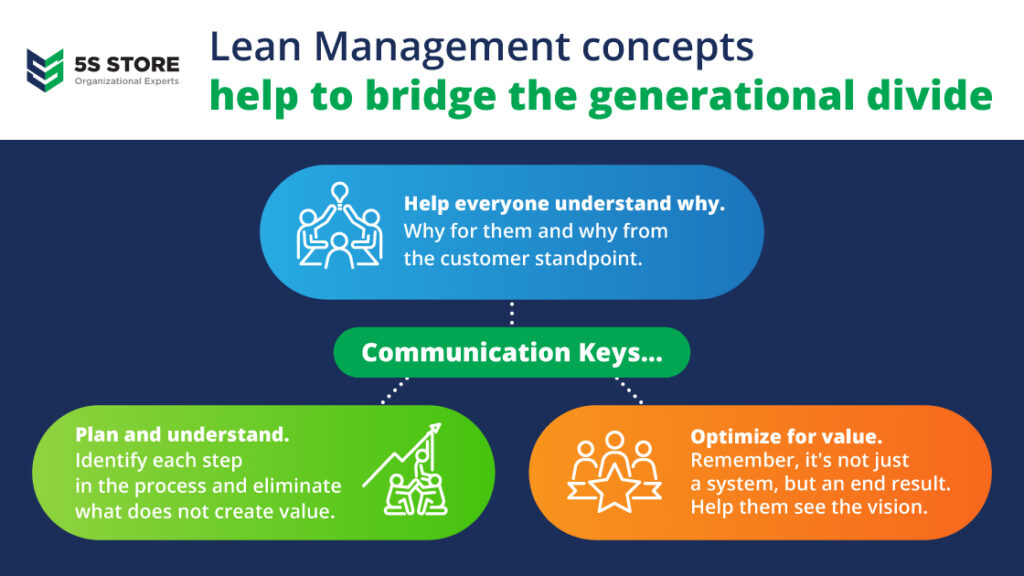
Communicating 5S in the Workplace Across 5 Generations of Workers

Communicating 5S in the workplace is both a wonder and a place where many of us encounter challenges. Moreover, we have never before had so many ways to communicate available to us. We’re familiar with that truth. What we sometimes forget is that the frustrations are about more than navigating Zoom calls and Slack rooms. It’s also about the unprecedented age range of modern-day workers.
Are you struggling to communicate your 5S programs at your workplace? Maybe check your generational divide.
Whether you’re on the manufacturing floor, in an office, or managing a warehouse, there is likely to be a larger diversity in your workforce than ever before. We tend to think of diversity as related to race, ability, or gender. We forget that age ranges are important here too. Luckily, bridging the generational gap when communicating about your 5S initiatives doesn’t have to be difficult.
There’s a top-down struggle to stay committed and sustain 5S initiatives. The environment is key to understanding how to communicate well…Understanding the generational makeup of a facility is part of understanding the environment.
Bob Burke “Baby Boomer”, VIP Group
For this piece, we spoke to professionals from each age range about their experience of work, communicating with colleagues, and what they wish their bosses understood about motivating them. Then, we researched what journalists and academic institutions had to say about the topic. What we present here is not scientific, it is our perspective on the generational divide presented through the lense of communicating about 5S initiatives.
We know that there is no one agreed-upon year that each generation begins or ends. However, there is general agreement that the five age ranges can be labeled this way:
- Baby Boomers – The children born to the World War II generation, generally born between 1946 and 1954.
- The Lost Generation (Sometimes called Boomers II) – Some sources consider the end of the Baby Boomer years to be the beginning of Gen X. However, others mark an often neglected, and we think unique, set of characteristics that belong to those born between 1955 and 1964. This is the first post-Watergate generation.
- Gen X – Children born between 1965 – 1976 are also sometimes called The Lost Generation because they are sandwiched between Baby Boomers and Millennials in terms of resources. They are the first generation of American kids to grow up with large percentages of divorce, daycare, and the beginnings of modern computing.
- Millennials – Much has been written about the first generation of cell-phone and internet owning kids. This term usually refers to people born between 1981 and 1996.
- Generation Z – The youngest workers in your office are no longer millennials. Over the last couple of years, Generation Z has begun their careers. These are workers born between 1997 and 2012. Gen Z is the first Americans to be born into a world without smartphones or the internet.
Each generation shares both similarities and differences. That means understanding where we could have gaps in communication styles helps us work together on our goal of continuous improvement. What follows is an overview of what we learned, a deeper look at one professional in each age group, and a few suggestions on what to do to communicate more effectively with each group.
What we learned about communication across the generations.
It’s important to say upfront that the differences between the generational groups are smaller than sometimes expected, based on how much is written about them. And, at the same time, what is different is significant when communicating at work.
If we are making the case for 5S with different age groups, considering how they prefer to receive recognition, perceive their roles, and learn from each other can significantly impact our results.
We expected that the larger the age gap, the bigger the communication differences would be. We were wrong.
Our expectations were that Baby Boomers and Generation Z to be the most different. While there are huge gaps in how each group uses technology, when we removed the question of smartphone versus landline we found that the oldest and the youngest age groups shared these communication preferences:
- Baby Boomers and Gen Z are quick to share their individual preferences and perspectives. They also appear to find teamwork more challenging than other groups do.
- Both older baby boomers and Gen Z, the newest group to enter the workforce, feel like those of other age groups speak to them as if they were children. This wrangles them. Although each group is coming at this frustration from a different angle, when communicating with both older and younger workers, try to treat them as equals. They say they can handle it.
- Urgency tends to be a hallmark of Millennials and Gen Xers. As far as we can tell, other generations are much less concerned with time constraints.
Remember, we tend to over-simplify the differences between people when we look at them as monoliths in any group.
When it comes to thinking about generational communication, it matters more to think about the context of the world these workers grew up in than how old they are. In fact, most generational differences are generalizations based on large-scale cultural, economic, and societal movements during the childhoods and early adulthoods of people.
People my age are skeptical about Lean and all it’s sub-groups. It doesn’t hold as much allure as it seems to for other groups. But then, I feel like we are more skeptical about everything.
Brian Murphy “GenX”, Lean Practitioner
In that sense, a worker who grew up in a post-9/11 world might have much more in common with a worker who grew up in a Cold War-era world than you might think.
Shifting cultural norms play a huge role in the communications gap. That’s why the children of the social media age have one huge difference we continually came across with their pre-1980-born colleagues…
Talking back to the boss is a big frustration to many over 40(ish) workers when communicating with their younger counterparts.
It may be that part of the criticism of the younger generations by the older comes from this big difference:
Millennials and Gen Z-age workers do, on average, question authority figures much more often than their older counterparts.
This matters because a question or critique that an early-30s-age worker poses to a superior can seem like insubordination to an older boss. When in fact, the “young upstart” was actually showing what she considers a level of maturity and trustworthiness by expressing her concerns in a transparent way.

A Generation-by-Generation Guide to Intergenerational Empathy and Communication
As we cautioned at the beginning of this piece, it can be easy to blame the generational divide for everything. We encourage you not to do that. While understanding the gaps which often occur based on age is key to better functioning teams, it is only one small piece of the overall puzzle. Use these guidelines as jumping-off points to better understand, not be-all-end-all rules.

Working with Baby Boomers? Then, remember to keep it professional.
Remember that older workers grew up in a time with more rigid social rules than exist today. That means it’s key to empathize with professionalism in language, communication format, and adherence to a hierarchy often makes them feel more comfortable.
| Languaging Preferences | Business Professional Goal-centric and more formal than other groups, keep to complete sentences, formal titles and save the emojis for someone else. |
| Preferred Communication Preferences | Face-to-Face Especially if the conversation is touchy or important, communicate in-person whenever possible. |
| Emphasize This Why when communicating | Security Baby Boomers are often motivated by job security, maintaining their position within an organization, and prestige. |
| Possible Strengths Key to Your 5S Initiative | 1. Hard-Working 2. Committed 3. Experienced |
| Possible Challenges with Sustaining 5S Best Practices | 1. Sometimes Rigid 2. Recognition-motivated over results-motivated 3. Sometimes slow to adapt |

When working with the Lost Generation, help them feel seen.
Much has been said about Gen Xers being “The Generational Middle Child”. However, when a group literally gets left out of the labeling system (that’s a part of why they are called lost) it seems like middle-child analogies abound. People in this group largely want to feel seen, because they are so often overlooked.
| Languaging Preferences | Casual Professional Less concerned with formality than Baby Boomers, but not completely open to shortened phrases or the lack of social graces. Keep communication professional, but Emily Post’s rules are not required. |
| Preferred Communication Preferences | Face-to-Face Especially if the conversation is touchy or important, communicate in-person whenever possible. |
| Emphasize This Why when communicating | How It Benefits The Team Workers in this group tend to be skeptical, but want to be part of a team. Explain the benefits to the group when communicating new initiatives and coaching. |
| Possible Strengths Key to Your 5S Initiative | 1. Hard-Working 2. Understand the value of communication 3. Skeptical |
| Possible Challenges with Sustaining 5S Best Practices | 1. Sometimes judgemental 2. Sometimes lean towards analysis-paralysis 3. Skeptical |

Communicating with GenX workers? Pragmatic explanations are key.
Gen Xers tend to be highly educated and able to communicate well at work. They usually feel comfortable in both digital and in-person interactions. A common misconception is that workers in this group are not as internet-savvy as their younger counterparts. That’s simply not true. They know their technology AND know how to handle more traditional business etiquette. It’s a powerful combination of skills.
| Languaging Preferences | Whatever Works for You Largely defined by the personal computing age, but often beginning their careers in more formal environments, Generation X communicates easily in almost any style |
| Preferred Communication Preferences | Whatever Works for You (As long as it’s to-the-point) In-person, by text, or email. Simply keep it simple and on-point. |
| Emphasize This Why when communicating | How It Benefits The Team Workers in this group want to be seen as individuals. They need you to tune into WIIFM–What’s In It for Me? |
| Possible Strengths Key to Your 5S Initiative | 1. Hard-Working 2. Independent and self-sufficient 3. Flexible |
| Possible Challenges with Sustaining 5S Best Practices | 1. Tend to dislike hands-on management styles 2. Rugged individualism can sometimes hinder teamwork 3. Often unlikely to ask for support when they need it. |

Are millennials flooding your facility? Think beyond their bad rap at what work-life has been like for them.
Millennials make up the largest generation in the workforce right now. Many came-of-age in post-9/11 America and graduated from college during the worst recession in post-Depression America. Because of these experiences, Millennials are empathetic, skeptical, and professionally savvy. Despite being the most educated generation in American history, more millennials households have incomes below the national poverty level than any other age group. It’s important to consider this context to understand how they communicate at work.
| Languaging Preferences | Digital – Shorthand This age group often has little time for social niceties. Too-the-point texts or messages in apps (like Slack) tend to be preferred for most types of communication. |
| Preferred Communication Preferences | Text or App-Based Text messages and apps are generally preferred for all types of communication except the most serious coaching conversations. |
| Emphasize This Why when communicating | How They Fit Inside the Bigger Picture Millennials are often a hybrid of individualism and connectedness. They want to feel like they are contributing to a bigger vision and see how their efforts fit into the bigger picture. |
| Possible Strengths Key to Your 5S Initiative | 1. Resilient 2. Thoughtful 3. Resourceful |
| Possible Challenges with Sustaining 5S Best Practices | 1. Anxious 2. Often lack a sense of loyalty to any one organization 3. Sometimes impatient for the result of their actions |

As GenZ workers enter the job market, consider these communication strategies.
It can feel like Generation Z was born with a smartphone in hand. That can be both a blessing and a curse. The newest generation to enter our warehouses, manufacturing floors, and offices offer a lot of possibilities to our workplaces. Gen Z workers tend to be flexible, socially conscious, and more adaptable than many people expect.
| Languaging Preferences | Digital Shorthand This age group often has little time for social niceties. Too-the-point texts or messages in apps (like Slack) tend to be preferred for most types of communication. |
| Preferred Communication Preferences | Text or App-Based Text messages and apps are generally preferred for all types of communication except the most serious coaching conversations. |
| Emphasize This Why when communicating | How They Fit Inside the Bigger Picture Gen Z is hyper-connected. They need to understand both how they fit in the team and the instant result of their next action. |
| Possible Strengths Key to Your 5S Initiative | 1. Malleable and trainable 2. Socially Conscious 3. High levels of empathy |
| Possible Challenges with Sustaining 5S Best Practices | 1. Easily offended 2. Often have issues with needing/wanting instant gratification 3. Often coming into the workforce with less practical life experience than previous generation |
Technology adoption is not the only thing that impacts communication styles. Our best advice? Stop using it as an excuse for the gaps in connection.
There are a few important differences in communication styles between the five generations currently in the workforce. Yet many oldies-but-goodies remain the same. Every person we talked to said some version of the following three things:
- Make us feel like we matter. It doesn’t matter how good your vacation policy is if people don’t feel valued. Communicate why and how your initiatives, 5S or otherwise, will benefit them. Then, take that one step further and help them understand how their unique skills contribute to the bigger picture.
- Slow down. Talk less. Listen more. All generations feel that their leaders and managers often don’t listen to the employees the way they should. This goes back to number one, slow down. Listen to them. That will help your teams, no matter how old they are, feel like you care.
- Follow through. What we do often communicates as strongly as what we say. Make sure to follow through on your promises, initiatives, and programs. Every time we say something matters and then forget it, our teams believe us less the next time.
Managing your 5S teams (and beyond) will be easier if you take into consideration these three truths. They are simple, but not always easy to sustain.

